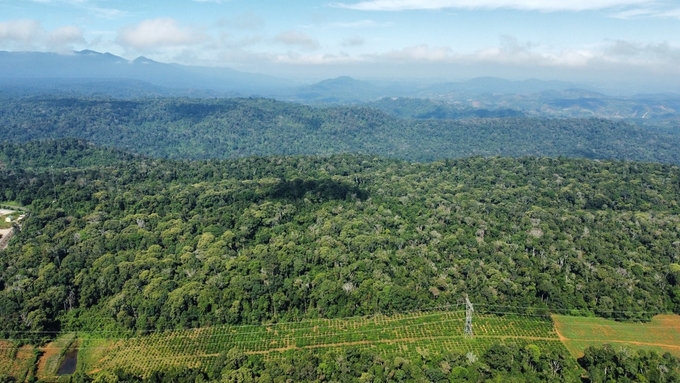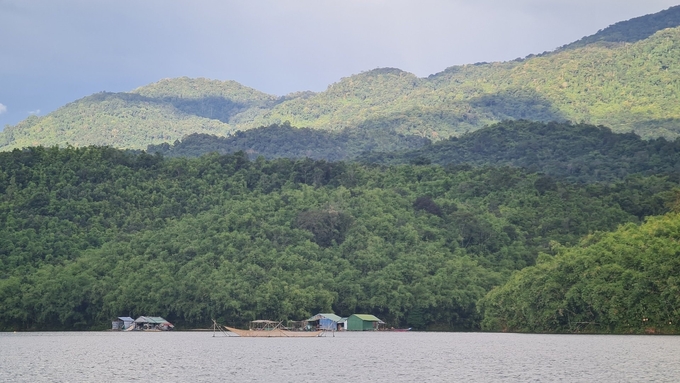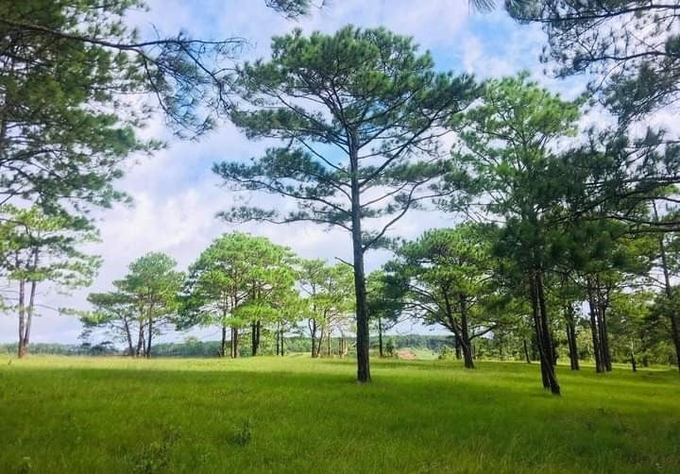June 1, 2025 | 05:16 GMT +7
June 1, 2025 | 05:16 GMT +7
Hotline: 0913.378.918
June 1, 2025 | 05:16 GMT +7
Hotline: 0913.378.918
Dak Nong currently has approximately 293,000 hectares of forestry land, accounting for 45% of the natural area. According to the review, the total area of forested land is nearly 251,000 hectares (including over 196,000 hectares of natural forest and approximately 55 hectares of planted forest). This locality is assessed as having great potential for developing carbon credits.
Ta Dung National Park has a natural area of about 21,000 hectares, covering more than 85% of the core area (over 48% of primitive forest and over 36% of secondary forest of all types). Currently, in Ta Dung National Park, the forested area is over 16,000 hectares, characterized by multi-layered wet tropical evergreen forest. In particular, the primitive forest area accounts for the majority, so it has the potential to absorb and store carbon.

According to the review, Dak Nong has a total area of forested land of nearly 251,000 hectares. Photo: Quang Yen.
Besides, Ta Dung National Park has about 5,000 hectares of restored forest area, which is in a period of rapid growth. The carbon absorption and storage of the forest here is also an advantage. In particular, the bamboo forest and the mixed bamboo and wood forest are also assessed as having a higher ability to absorb and store carbon than other forests.
Mr. Khuong Thanh Long, Director of Ta Dung National Park, said that in recent times, the unit has planted more than 600 hectares of forest, and now over 300 hectares have become forest. According to Mr. Long, with a large natural forest area, the unit is considered a large carbon storage place in Dak Nong province. "If carbon credits are deployed, they will contribute to increasing the unit's revenue. This helps the unit have a source of payment and strengthens forest management and protection," said Mr. Long.
Similarly, the Thac Mo Protection Forest Management Board currently manages more than 6,500 hectares of forest and forest land. The specificity of the forest here is that it is an evergreen forest. Mr. Nguyen Xuan Khuong, Director of Thac Mo Protection Forest Management Board, said that the unit's forest area is assessed as one of the most important places for preserving standard samples of the ecosystem. Thanks to the fairly intact forest ecosystem, mainly primitive forest, this is an area with a lot of potential, ready to implement and participate in the carbon credit market.

Ta Dung National Park is one of the units with the largest potential to participate in the carbon credit market in Dak Nong. Photo: Quang Yen.
Mr. Pham Tuan Anh, Director of the Dak Nong Department of Agriculture and Rural Development, said that the total area of forested land in Dak Nong is large, and the coverage rate reaches 39.07%. According to Mr. Pham Tuan Anh, with a very large forest area and quite high forest quality and reserves, the province has a lot of potential for developing carbon credits. Besides, Dak Nong province has a planned area for forest development of nearly 80,000 hectares. Restoring forests in this area will increase the rate of forest coverage and forest carbon reserves.
"Developing forest carbon credits means having to perform tasks and solutions well to improve forest quality. Of which, the locality will focus on implementing good management of existing forest areas, strengthening forest development, developing the forest economy, etc. Developing carbon credits is an opportunity to supplement financial resources to increase income and improve the livelihoods of forest owners and people, thereby supporting forest management and protection," Mr. Pham Tuan Anh added.
Currently, the implementation and development of the forest carbon credit market are still new without specific instructions, so forest owners and functional agencies in Dak Nong cannot implement it.

Currently, despite having many advantages, Dak Nong also faces many difficulties when participating in the carbon credit market. Photo: Quang Yen.
Mr. Nguyen Xuan Khuong said that forest carbon credits are still quite new, and detailed instruction documents for implementation are not yet available. Therefore, the unit wishes to soon establish a project that can be implemented to increase sustainable revenue. "Currently, the carbon credit mechanism is not clear. In particular, the most difficult thing for the unit is that there is no funding to implement the project. If participating in the carbon credit market, the top priority is to find funding sources," said Mr. Khuong.
Meanwhile, Mr. Khuong Thanh Long said that the unit is now facing many difficulties in terms of the unclear legal mechanism for investigating and implementing forest carbon certificates, especially how to use the money collected. "Currently, the carbon market is in pilot and sponsored form. Regarding investigation methods, there is no consensus; there is no method considered optimal, especially in the Tropical Rainforest National Park with many tree species and canopy layers. And most importantly, the human resources and funding to investigate the amount of forest carbon absorption are huge, and it requires implementation on a 2–5 year cycle," Mr. Long said.
Talking to reporters, Director of the Department of Agriculture and Rural Development Pham Tuan Anh said that in order to best prepare for implementation, in recent times, the unit has regularly sent staff to consult and attend conferences organized by the Ministry of Agriculture and Rural Development to update knowledge about carbon credits.

It is expected that by 2025, Dak Nong province will issue carbon credits, estimated to earn USD 10/credit. Photo: Quang Yen.
However, Mr. Pham Tuan Anh said that currently, the development of carbon credits in general and the mechanism for operating forest carbon credits in particular are still in the initial stage. "The mechanisms and regulations for measuring, exchanging, and offsetting carbon credits, etc., are not complete and lack uniformity. On the other hand, implementing carbon projects and measuring and establishing credits requires high financial, technical, and human resources, which Dak Nong province is now limited," Mr. Tuan Anh emphasized.
Translated by Thu Huyen

(VAN) Several scientists and farmers are experimenting with soil treatment in some key durian-growing regions such as Cai Lay (Tien Giang), Dak Song, Gia Nghia, and Dak R’lap (Dak Nong).
/2025/05/25/4127-3-073637_820.jpg)
(VAN) Thanks to the promotion from an FAO-implemented project, vegetable production in greenhouses in Moc Chau has seen strong development, from 1.5 hectares in 2021 to nearly 50 hectares in 2024.

(VAN) FAO has recently supported USD 140,000 to implement the project 'Risk mitigation human-animal interface risks through disease control initiatives in pig farming.'

(VAN) The People's Committee of Tra Vinh province has approved an adjustment to the investment policy for the Green Hydrogen Plant project, increasing its area to approximately 52.76 hectares.
![Reducing emissions from rice fields: [2] Farmers’ commitment to the soil](https://t.ex-cdn.com/nongnghiepmoitruong.vn/608w/files/news/2025/05/05/dsc08881jpg-nongnghiep-140632.jpg)
(VAN) Clean rice cultivation model in Thuong Tan commune, Bac Tan Uyen district, is assisting local residents in achieving sustainable agriculture by substantially reducing costs, increasing productivity, and protecting the environment.

(VAN) At the conference to disseminate Resolution No. 68, AgriS introduced its digital agricultural ecosystem and reaffirmed its commitment to accompanying the Government in promoting private sector development and sustainable agriculture.

(VAN) 'Blue Ocean - Blue Foods' initiative is designed to restore marine ecosystems and establish sustainable livelihoods for local communities by cultivating a minimum of 1,000 hectares of cottonii seaweed in the first three years.